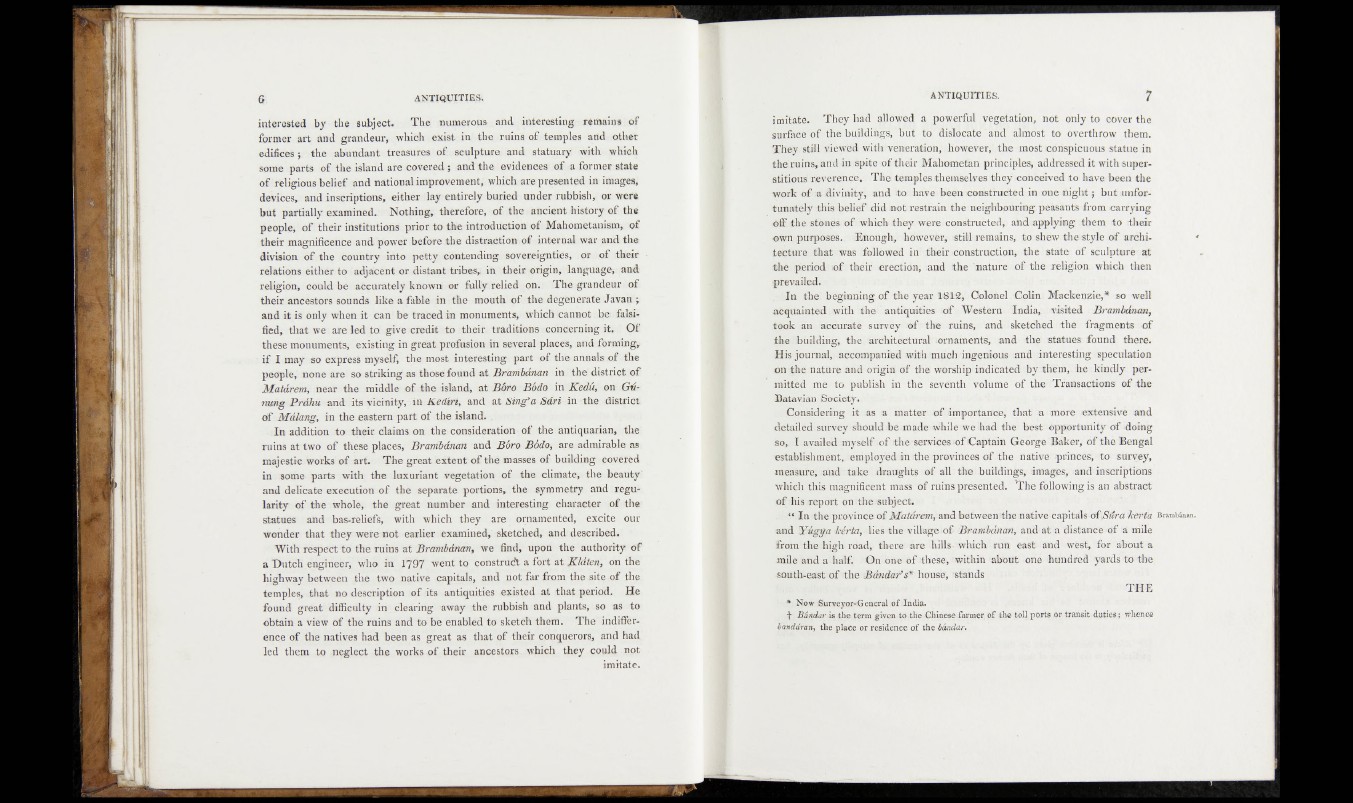
interested by the Subject. The: numerous and interesting remains of
former art and grandeur, white exist- in; tens ruins of temples and other
edifices; the abundant treasures of. sculpture and statuary with 'which
some parts of the island are cohered; and the evidences of a former, state
of religious belief and national improvement, which are presented in images,
devices, and inscriptions, either lay entirely buried under rubbish, or were
but partially examined. Nothing*, therefore, •.«£ .tee rWicie»* \a#Wf*£ the
people, of their institutions prior to the introduction of Mahometanism, of
their magnificence and power before the distraction of internal war and the
division of the country info petty 'contending: sovereignties, or off their
relations either to adjacent or distant tribes, in their origin, language, and
religion, could, be accurately known or fttliyreliedpn. The grandeur: of.
their ancestors sounds like a fable in j the mouth of the degenerate Javan ;
and it is only when it can be traced in monuments, V?bicfi cauii®i ;ibe:falsj'
fied, that we are led ta give credit to their traditions concerning -iff; Qf
these monuments, existing in great profusion in several plaeefe, and ilrsiogii
• if I imay so express myself, the most interesting part -.©£•-tee annals. of the
people, none are so striking as those found at Brambdnan in. the! district ©f
Matdrem, near the middle of the island, at Bbro Bbdo in Kedti,. on G6-
nung Prahu and 'its vkdsity,’. in Kedtri, and at &in£a Sari rln-the district:
of Malang, in the eastern part of the island. .
In addition to their claims on the consideration of the antiquarian, the'
rains at two of these places, Brambdnan and Boro Bbdo, are admirable as
majestic works of art. The great extent of the masses of budding covered
in some parts with the luxuriant -vegetation of the climate,' the beauty'
and delicate execution of the separate portions, the symmetry and ®egu>
larity of the whole, the great number and interesting character of the
statues and bas-reliefs, with which they are ornamented, excite our
wonder that they were not earlier examined, sketched, and described.
With respect to the mins at Brambdnan, we find, upon the authority of
a Dutch .engineer, who in 1797 went' tq construct a fort at Kldten, on tee
highway between the; twe native «capitals, and not far from thc-isite of the
temples, that no description of its antiquities existed at that period. He
found great difficulty in clearing away the rubbish and plants, so as to
obtain a view of the ruins and to be enabled to sketch them. The indifference
of the natives had been as great as that of their conquerors, and had.
led them to neglect the works of their ancestors which they could not
imitate.
imitate. T h ^ h ad a llow ed a pqwCTM .v eg e ta tio n , n ot on ly to cov e r th e
su r fa c e 'o f^ ^ b j!H® m |B , b u t • t o a i s K im e ‘ and almost to overthrow them.
They, still viewed wiifhlvefeaiioh,:however, the most conspicuous statue in
tfae'tuinSj knd in .spiterofi'thar Mahometan principles, addressed it with superstitious
reverence.;, .Tlfte temples teemselves »they .conceived to have been the
■ work of a te vimty', and sto;. have been constructed te-me nighit | bnt amfor-
tunately teis belief did motrestrain the :Beighb£)ncrng peasants from carrying
off the. stones of 'whiefefbey were . ceasfcFiaèted, ahd applyiiiig them to their
own purposes., d^sougl%t: hibsesÈn,' still remains** ^ooshtiiwi the style .of anehi- -1
tecture that was followed in their construction, the state' of sculpture at
the period . and the 'smture£xffitee>xeli$fc>n, which teen
prevailed.
, sin the beginning. of ten yhar MS3ig,: .Gnldnel. Cddn. Mackenzie,* so well
acquainted with the' antiquities r f Western India, visited Brambdnan,
took dn accurate snrvey sëf the ruins, andf sketched teë fragments r f
the building, the architectural »ornaments, .and the statues found there.
His journal, accompanied with miieh ingenious and interesting: speculation
«n ’the.nathre and- origin df the worship indicated -by'-them,. ibe: kindly permitted
meVfo publish in the vipylmh■> volume of tee Transactions of tee
Batavian Society.
Considering it as a matter of iaiportartoe, teat a more extensive and
detailed. survey should ibe made while -we ihad tee best opportunity of doing
so, I availed :myselfeof tee servioee*of Captain ©eerge Baker, óf the Bengal
establish men t,«temployod in tee provinces o£ *tee native- princes, -'to^ survey,
measure, and take draughts of all the buildings, images, >a*d inscriptions
which this magnificent mass of ruins presehted. Thè following;® an abstract
of :his report on fbejsubjecfc.
“ Intthe:province ’oïMutarem, &ndi betweenitlrenattive capitals ctf’yS'^ra 'kertü BamtE«.
and ’Yïégp.a Mrta, Ides the village \o-$fBra<nd}dnxm, and at a distance *qf a mile
from tee high road, tsbete are ihills-^which I run east and w&sfc, -for about a
mile and a half. On one of these, 'within abotft One (hundred yards’to the
south-east of the Mmidar’s* house, stands
THE
* Now 'SurveyxjrvGenerRl :of India.
f Bandar is the term given to the Chinese .farmer, of the toll ports Or transit, d u tie swhence
banddran, the place or residence of the landcir.